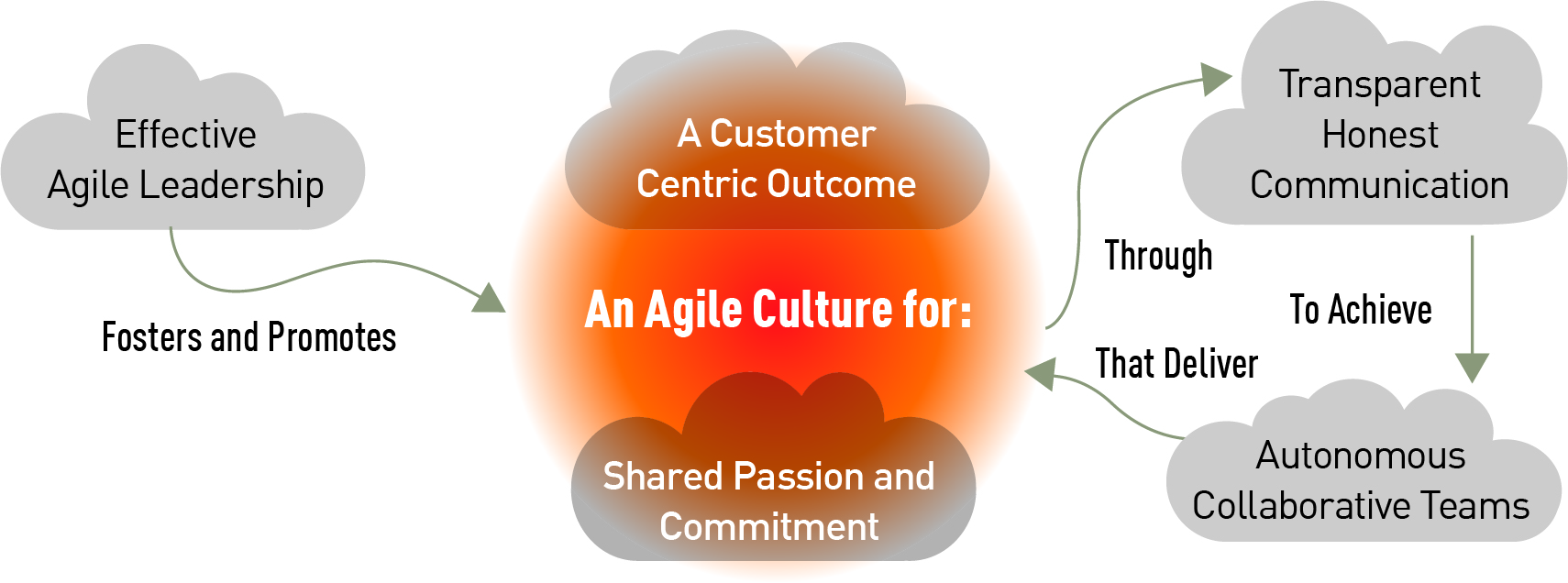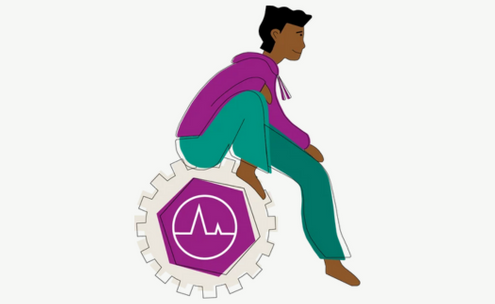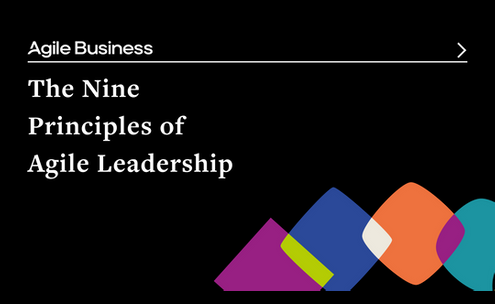Towards an Agile Culture: Agile Culture and Leadership
Introduction:
The Agile Business Consortium has been developing its thinking on culture, and specifically what agile culture means for organisations of all shapes and sizes. This paper takes the results of our comprehensive research into agile culture and sets out a vision of what it could mean for your organisation.
We are what we repeatedly do – Aristotle
Business agility
Business agility is concerned with the adoption and evolution of values, behaviours and capabilities that enable businesses and individuals to be more adaptive, creative and resilient when dealing with complexity, uncertainty and change, leading to improved well-being and better outcomes.
To be truly agile, an organisation needs to operate in a very different way, with leadership, values and norms all reinforcing the culture. To help define and create agile culture is one of the objectives of the Agile Business Consortium.
The culture and leadership workstream
Culture and leadership is essential for an organisation to function effectively both on a day-to-day basis as well as during times of change. The culture and leadership workstream was established to develop the agile, people-centric foundations that underpin and contribute to the wider business agility agenda and the Consortium’s Framework for Business Agility. Our first paper on culture and leadership explained how the concepts of communication, commitment and collaboration were key. These concepts were further developed by The Nine Principles of Agile Leadership that define the ideal behaviours shown by agile leaders. This paper defines and describes agile culture based upon research undertaken, underpinned by robust theories and the work done so far by the agile culture and leadership workstream. The paper also explains the symbiotic relationship between culture and leadership and how it shapes and influences change within organisations.
Defining an agile culture:
Here we propose a working definition of an agile culture:
Agile culture is about creating an environment that is underpinned by values, behaviours and practices which enable organisations, teams and individuals to be more adaptive, flexible, innovative and resilient when dealing with complexity, uncertainty and change.
(Based on the works of Ed Schein, Frederick Laloux, Vlatka Hlupic, Peter Senge and Alan Furlong)
The core values that the Consortium espouses
- Innovation & learning over the status quo
- Inspiring leadership over conservative management
- Collaboration and autonomy over hierarchical control
- Collective purpose over self interest
Guided by the agile culture DNA
Agile organisations are guided by deep, underlying assumptions, beliefs, and ways of working that permeate all levels within an organisation, and are replicated and passed on to other members. This cultural DNA, over time, will become deeply embedded, guiding “the way things are done here”.
Agile culture represents a complex variable that can bring people together, pull them apart or do both!
We define this DNA as being made up of the following elements:
- Unleashed purpose and meaningful results – a clear, compelling and inspiring purpose that focuses on results that matter to all stakeholders
- Agile leadership – supportive leadership over directive, command and control style
- Well-being and fulfilment - happy and positive over fear-based, stress, fatigue and burn-out, providing a deep sense and feeling of achievement to individuals
- Collaborative communities and distributed authority – a network of collaborative teams with more autonomy for decision-making as appropriate
- Trust and transparency– loyalty, integrity and commitment to transparency, openness and honesty on day-to-day working
- Adaptability to change – a strong core that provides stability with flexibility to adapt and change
- Innovation, learning and personal mastery – psychological safety, thoughtful experimentation, learning and reflective practice moving toward personal strengths and mastery
Any organisation that has (most of) these elements of DNA in its make-up will be well on the path to behaving in an agile way across all aspects of its business. This agile culture DNA resides amongst the people in an organisation and not as much in the structure, processes and systems.
Describing an agile culture:
Culture in a general sense can be described as “The way things get done around here”; a glue that binds an organisation together and is a source of lasting competitive advantage (Handy 1999, Mankins 2013).
Culture eats strategy for breakfast – Peter F. Drucker
Culture is about the basic underlying assumptions, values and belief systems that are prevalent across the entire organisation and its functions. Culture ultimately influences the actions of people and work groups and vice versa.
In describing an agile culture, it is helpful to view it as a construct comprising of three different levels (adapted from Schein 2016):
| Levels | Description | Agile culture attributes |
|---|---|---|
| Level 1 | Artifacts - visible and tangible signs of an organisation’s culture - they can be seen, heard and felt |
|
| Level 2 | Espoused ideals, goals, values, aspirations and beliefs (stated and unstated) of the organisation |
|
| Level 3 | Unconscious, taken-for-granted beliefs and values |
|
The aim should ideally be to see as much congruence as possible between “artifacts, espoused values and beliefs”. This is often not the case and leaves many behaviours unexplained. The unconscious assumptions often become non-debatable, form “mental models” of people and are hard to change.
Agile culture is also contextual, especially when it comes to behaviours, suitability of practices and cultural influences across the globe, which need to be taken into consideration. The nature of agile culture in different national contexts is an area that the Consortium wants to explore more fully with partners from different countries.
The competing values paradox
(Adapted from Competing Values Framework, OCAI Model, Denison Culture Model & Schneider’s Culture Matrix & McKinsey)
The Competing Values Framework is based on research conducted by Quin & Rohrbaugh (1981) which helps explain a paradox that is at play when it comes to defining the characteristics of an agile culture. Their research demonstrated a tension between four competing values: internal vs external orientation and stability vs flexibility
- Internal orientation – focusing inward on development, collaboration, integration of activities, coordination
- External orientation – looking at the market, competition, customer needs, diversifying activities
- Stability – values clear structures, planning, budgets, reliability and assumes it can be controlled
- Flexibility – prefers a flexible attitude and way of organising to adapt quickly to changing circumstances
The “competing values” nature prevents an organisation from being both internally-externally focussed or being stable-flexible at the same time. Cultures emerge from these values, change over time and help us in understanding a variety of organisational phenomena such as structure, quality, change, leadership and management skills.
The table below represents key characteristics of these four dimensions based on the above “competing values” – create vs control, collaborate vs compete. No one cultural dimension is better than the other. Organisations will typically have a dominant cultural dimension, with aspects from all the other dimensions also present in varying degrees. Furthermore, different departments, functions and groups within the same organisation will have these cultural dimensions in varying degrees as well.
Collaborate |
Create |
|
|
Control |
Compete |
|
|
It takes both leadership and management to strengthen, maintain, change, or create a culture in all of the above dimensions. Change without stability is chaos; innovation without productivity is a waste. An agile culture, therefore, is not typified by just one dimension but is about having an appropriate balance to achieve its purpose. The dominance, preference and orientation towards one or the other dimensions will change over time, heavily influenced by geographical and local socio-cultural factors.
The above statement is supported by research on agile method adoption and culture (Spyad 2010), which observed that the dimensions of “collaborate” and “create” were best suited to agile ways of working. The dimensions of “control” and “compete”, however, were also present, confirming the “competing values paradox” described earlier.
McKinsey (2015, 2016) conducted extensive research on this subject and found that truly agile organisations, learn to be both stable (resilient, reliable and efficient) and dynamic (fast, nimble and adaptive) across three dimensions of people, processes and structure at the same time.
On the culture side, the stable backbone is about:
- Strong shared values, emphasis on accountability and collaboration
- Leaders aligned on behaviours and “how we run the place”
The dynamic ability (flexibility) is about:
- Helping people to ignite personal purpose and passion
- Live the idea of growth/innovation every day
Interestingly, the “competing values” nature prevents an organisation from being both internally-externally focussed or being stable-flexible at the same time. The McKinsey research, however, highlighted that truly agile organisations are both stable and flexible as well as internally and externally focussed!
Agile methods suitability
Agile methods and practices may not be suitable for every situation. Rigby, Sutherland and Takeuchi (2016) identified the following favourable and unfavourable conditions for Agile methods:
| Conditions | Favourable | Unfavourable |
|---|---|---|
| Market Environment |
|
|
| Customer Involvement |
|
|
| Innovation Type |
|
|
| Modularity of Work |
|
|
| Impact of Interim Mistakes |
|
|
Whilst the culture may share the universal agile values and the agile culture DNA, the prevalence of agile methods and practices, and their adoption will be dependent on the above factors.
Socio-cultural factors
According to Meyer (2014), we are conditioned to see the world through the lens that is influenced by the environment and socio-cultural influences; it is in our biological DNA!
We live in a global economy and teams are often distributed across different countries. Only when we start to identify what makes one culture different from others, do we begin to understand, share and learn. Meyer (2014), through her extensive research identified a culture map that helps us understand how people think, lead and get things done across different cultures. The culture map comprises of:
- Communicating - low-context vs high-context
- Evaluating - direct negative feedback vs indirect negative feedback
- Persuading – principles-first vs applications-first
- Leading – egalitarian vs hierarchical
- Deciding – consensual vs top-down
- Trusting – task-based vs relationship-based
- Disagreeing – confrontational vs avoids confrontation
- Scheduling – linear-time vs flexible-time
Bains (2015), provides in depth commentary on cultural DNA which explores differences and similarities in cultures across the continents. His research found each culture’s instincts are finely attuned to the environmental challenges faced in different parts of the world.
The ecology of a new global world provides a unique context to further our understanding of an agile culture. We need a deep understanding and genuine empathy for the paradox that exists - differences and similarities across different world cultures.
Whilst an agile culture may share the universal agile values, and the agile culture DNA, how it is played out will be heavily influenced by the cultural diversity across the globe.
Agile culture and leadership:
According to Schein (2016), the primary role of leadership is in building, embedding and evolving culture. How agile leaders of an organisation believe things should be done drives the kind of agile culture that is established.
Agile culture and agile leadership have a symbiotic relationship
Leaders create new groups and organisations, thereby creating new cultures. Once established, that culture will define what kind of leadership will be valued and tolerated. As the organisation grows, the role of the leader shifts to maintaining and consolidating the existing culture, which then defines what the desired characteristics of leadership are!
As the organisation grows further, the existing culture may become dysfunctional to some degree, and the responsibility falls on the leaders to manage the direction of the evolution of the culture.

Figure 1:Towards business agility
The Nine Leadership Principles
The Consortium has published The Nine Principles of Agile Leadership that underpin the desired behaviours from leaders that set the tone for agile culture:
- Actions speak louder than words
- Improved quality of thinking leads to improved outcomes
- Organisations improve through effective feedback
- People require meaning and purpose to make work fulfilling
- Emotion is a foundation to enhanced creativity and innovation
- Leadership lives everywhere in the organisation
- Leaders delegate appropriate power and authority
- Collaborative communities achieve more than individuals
- Great ideas can come from anywhere in the organisation
Agile culture, leadership and change:
Organisational change, in general, is a sum of various parts such as technology, processes, structure, people, culture and practices.
Change is a necessary condition of survival and growth, be it for individuals or organisations – Charles Handy
Changing culture, however, is a difficult endeavour and requires a great deal of commitment and dedication from the leadership team to make it work. Culture is a very powerful reinforcer and any change that is in direct conflict with the prevailing underlying assumptions, values and beliefs, will not work.
An agile culture should always be learning, developing and evolving so an end goal should never be reached. Agile values and culture DNA, however, provide us with a solid foundation on which to build an organisation that is adaptable, flexible and responsive to complexity, uncertainty and change.
Agile culture and leadership principles are interrelated and are the base upon which effective change is built. Agile leadership is essential to focus and navigate the change; without it, the current culture will prevail and a diluted form of organisational change will emerge. With agile leadership and sponsorship from key stakeholders and influencers, an agile culture can emerge and become embedded to the benefit of the organisation and all its people.
All references are included in the downloadable PDF below.


